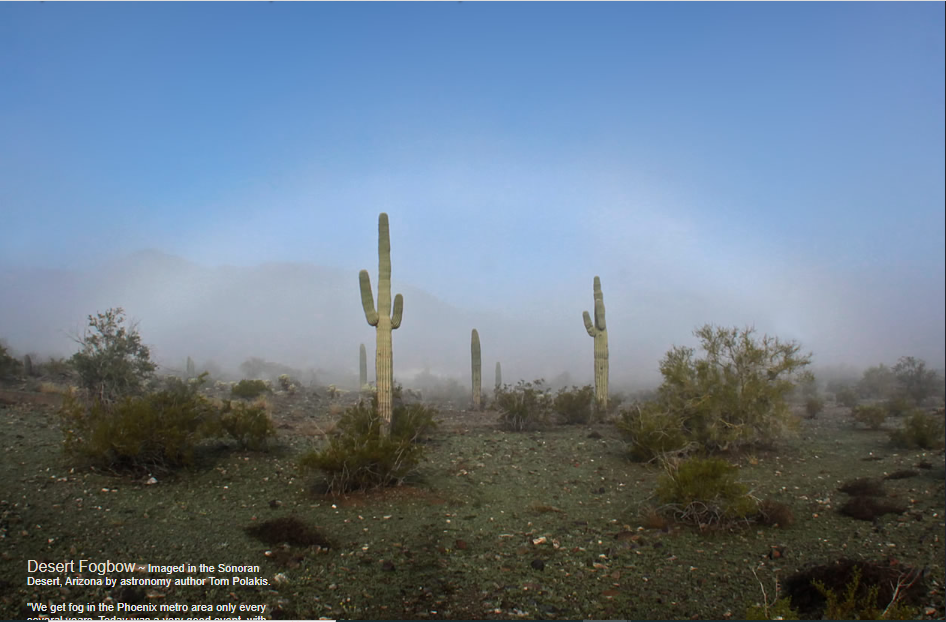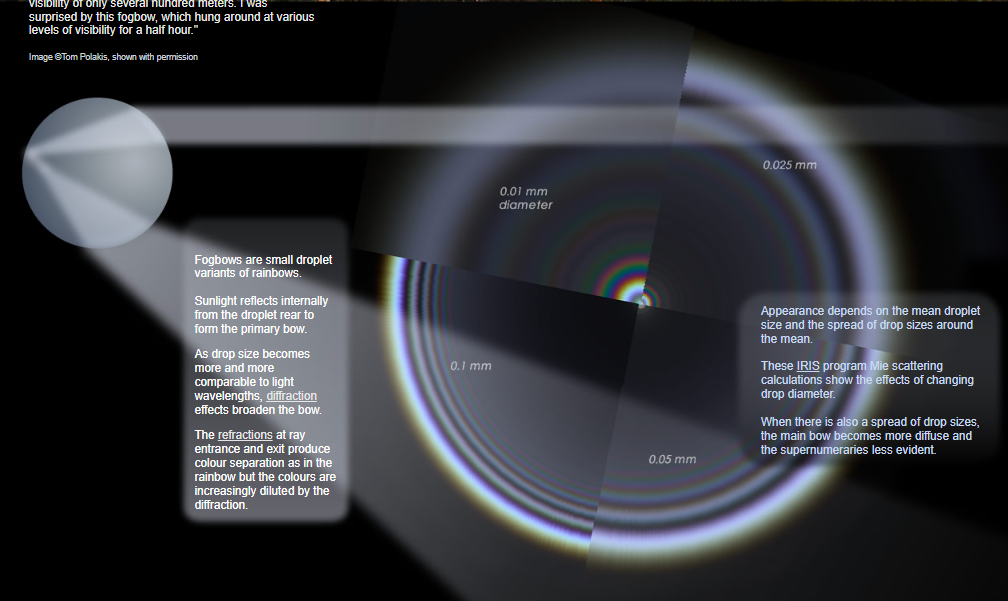Desert Fogbow - OPOD
Desert Fogbow - An Enchanting Atmospheric Phenomenon
Have you ever witnessed a fogbow? These captivating optical phenomena are a variation of rainbows, but instead of occurring during rainfall, they manifest in the presence of fog. Recently, an exquisite desert fogbow was imaged in the Sonoran Desert, Arizona by astronomy author Tom Polakis. In this article, we will delve into the mesmerizing world of desert fogbows, exploring their formation, characteristics, and the factors that influence their appearance.
Understanding the Formation of Desert Fogbows
Fogbows are formed when sunlight interacts with tiny water droplets suspended in foggy air. As sunlight enters these droplets, it reflects internally from the rear surface, creating a primary bow. Unlike rainbows, which are formed by the refraction and reflection of light in raindrops, fogbows are composed of smaller droplets. Due to their diminutive size, diffraction effects come into play, causing the bow to broaden.
The Role of Droplet Size and Diffraction
The appearance of a fogbow is influenced by two key factors: the mean droplet size and the spread of droplet sizes around the mean. As droplet size approaches the wavelength of light, diffraction becomes more pronounced, resulting in a broader and less distinct bow. The refractions that occur at the entrance and exit points of the rays also contribute to color separation within the bow, similar to rainbows. However, due to diffraction, the colors in fogbows appear diluted compared to rainbows.
Exploring the Influence of Droplet Size on Fogbow Appearance
To gain further insight into how droplet size affects fogbow appearance, let's examine IRIS program Mie scattering calculations. These calculations demonstrate how changes in droplet diameter impact the fogbow's characteristics. When there is a spread of droplet sizes, the main bow becomes more diffuse, and the supernumerary bows, which are faint additional bows sometimes visible on the inner edge of the primary bow, become less evident.
A Rare and Captivating Sight
Desert fogbows, like the one witnessed in the Sonoran Desert, are particularly enchanting due to their infrequency. In the Phoenix metro area, fog events are a rare occurrence, happening only every several years. When these atmospheric conditions align, creating fog with limited visibility, the emergence of a fogbow becomes even more extraordinary. Tom Polakis was fortunate to witness this captivating phenomenon, which lingered at various levels of visibility for approximately thirty minutes.
Conclusion
The allure of desert fogbows lies in their ethereal beauty and the rarity of their occurrence. These captivating optical displays, formed by sunlight interacting with tiny water droplets in foggy air, offer a unique twist on the traditional rainbow. As droplet size and diffraction play a role in shaping the appearance of fogbows, each sighting presents a slightly different spectacle. So, keep your eyes peeled during foggy days in desert regions, as you might just be fortunate enough to witness the enchanting dance of a desert fogbow in the sky.

Desert Fogbow ~ Imaged in the Sonoran Desert, Arizona by astronomy author Tom Polakis.
"We get fog in the Phoenix metro area only every several years. Today was a very good event, with visibility of only several hundred meters. I was surprised by this fogbow, which hung around at various levels of visibility for a half hour."
Image ©Tom Polakis, shown with permission

Fogbows are small droplet variants of rainbows.
Sunlight reflects internally from the droplet rear to form the primary bow.
As drop size becomes more and more comparable to light wavelengths, diffraction effects broaden the bow.
The refractions at ray entrance and exit produce colour separation as in the rainbow but the colours are increasingly diluted by the diffraction.
Appearance depends on the mean droplet size and the spread of drop sizes around the mean.
These IRIS program Mie scattering calculations show the effects of changing drop diameter.
When there is also a spread of drop sizes, the main bow becomes more diffuse and the supernumeraries less evident.
Note: this article has been automatically converted from the old site and may not appear as intended. You can find the original article here.
Reference Atmospheric Optics
If you use any of the definitions, information, or data presented on Atmospheric Optics, please copy the link or reference below to properly credit us as the reference source. Thank you!
-
<a href="https://atoptics.co.uk/blog/desert-fogbow-opod/">Desert Fogbow - OPOD</a>
-
"Desert Fogbow - OPOD". Atmospheric Optics. Accessed on April 16, 2024. https://atoptics.co.uk/blog/desert-fogbow-opod/.
-
"Desert Fogbow - OPOD". Atmospheric Optics, https://atoptics.co.uk/blog/desert-fogbow-opod/. Accessed 16 April, 2024
-
Desert Fogbow - OPOD. Atmospheric Optics. Retrieved from https://atoptics.co.uk/blog/desert-fogbow-opod/.